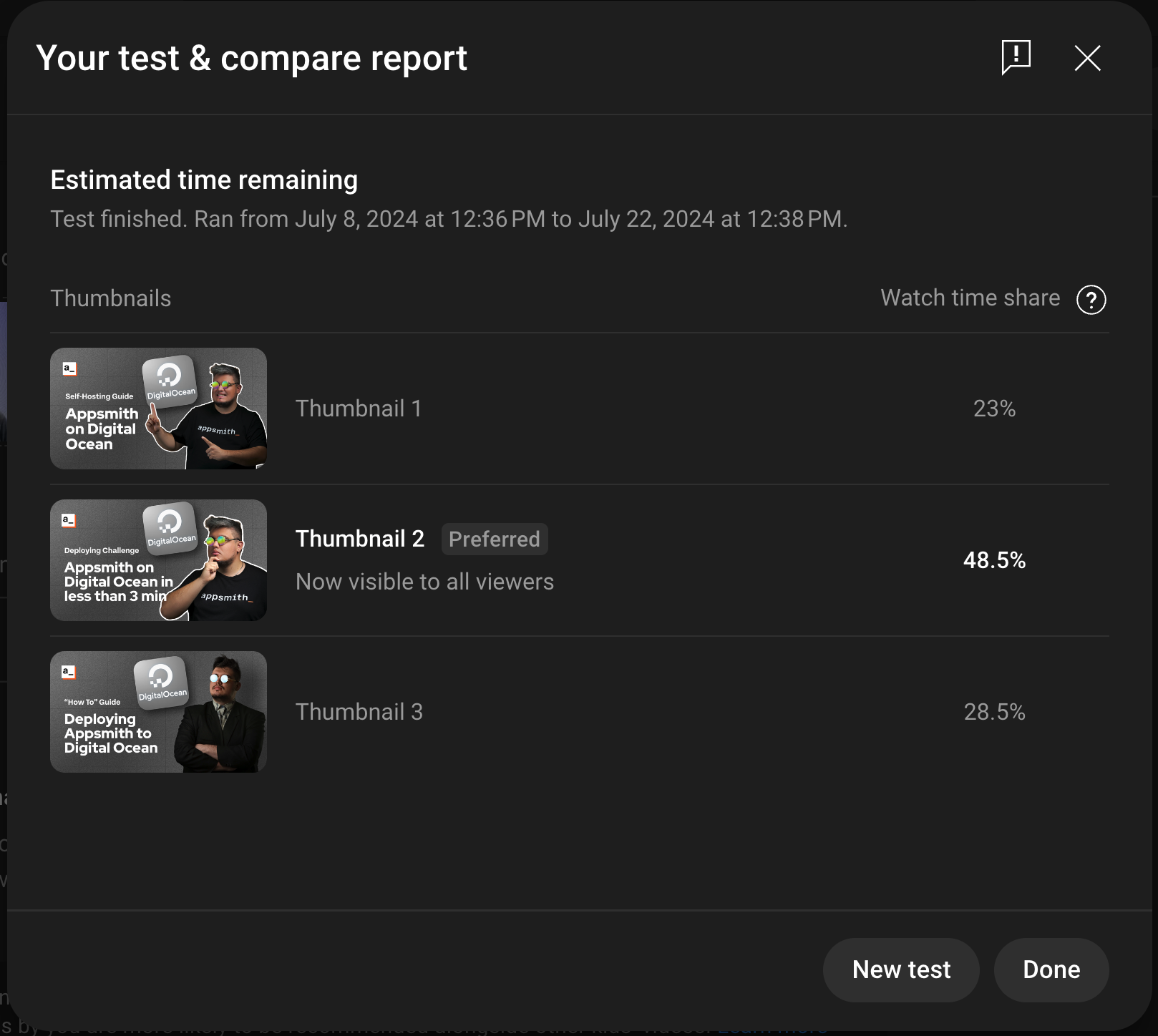A DevRel Guide for Video Thumbnails
 Kevin Blanco
Kevin Blanco
Viewers typically decide whether to click on a video in less than 2 seconds. For technical content, this means your thumbnail needs to convey relevance and value almost instantaneously.
As a Senior DevRel Advocate focused on Video Production for Developer Communities and Education with hundreds of videos produced, I've learned firsthand the critical importance of thumbnails for driving engagement and conversions. Through countless experiments, failures, and successes, I've gained valuable insights into what makes a thumbnail truly practical for a technical audience.
Why Thumbnails Matter for DevRel Content
When it comes to developer education and community building, capturing attention is half the battle. With an ocean of technical content available, your thumbnail is often the first and only chance to convince a developer that your video is worth their time. It's not just about aesthetics - a well-crafted thumbnail communicates value, relevance, and intrigue in a split second. This article aims to share what has worked for me after publishing more than 500 videos on different topics, areas, and products. Some well-produced videos have had less than 80 views. Some have had more than 20k, and I know that the thumbnail plays a crucial part in the result (among other things, obviously), and this is not a guide to becoming viral; this is a guide to showcase what the video delivers in a single image that can drive viewership.
The Developer's Scroll: A Unique Challenge
Developers are a discerning audience. They're often looking for specific solutions or in-depth knowledge and are quick to scroll past content that doesn't immediately signal relevance. This makes our job as DevRel professionals particularly challenging - and exciting.
Curiosity is King
Like in the general YouTube space, creating a "curiosity gap" is crucial. For developer content, this might mean hinting at a surprising solution to a common problem or showcasing an unexpected tech stack. Here's one example

Now, this is not clickbait. It's important to highlight that you don't need to lie; you can build curiosity from the thumbnail while delivering what's promised, so in your next thumbnail, spark some curiosity.
Technical Authenticity
While flashy designs can work for general audiences, developers often respond better to thumbnails that signal technical depth. Code snippets, architecture diagrams, or tool logos can be powerful scroll-stoppers for our audience.
For instance, if your video is about integrating a popular API or using a particular framework, consider incorporating a snippet of the relevant code or the framework's logo in the thumbnail. This approach not only adds credibility but also ensures that your thumbnail stands out in a sea of generic, overly-polished designs. The key is to balance simplicity with substance—ensuring that your thumbnail looks clean and professional while still conveying the technical depth your audience craves.

Furthermore, using actual screenshots or snippets from the video itself can enhance authenticity. Developers appreciate seeing a glimpse of what they will learn or achieve by watching the video. This transparency builds trust and increases the likelihood of engagement.
Remember, your goal is to create a thumbnail that not only grabs attention but also sets the right expectations. By emphasizing technical authenticity, you're telling developers that your content respects their time and expertise, making them more likely to click and engage.
Problem-Solution Framing
Developers are often searching for answers. Thumbnails that clearly communicate "I have the solution to your problem" tend to perform well. To achieve this, your thumbnail should be designed to quickly and clearly convey both the problem your video addresses and the solution it offers. This can be done through a combination of visual elements and text.

For example, if your video is about resolving a common error in a popular programming language, the thumbnail might feature a snippet of the error message alongside a visual cue like a checkmark or a resolved icon, indicating that the video contains the solution. Accompanying this with a short, impactful text overlay—something like "Fix [Error Code]" or "Resolve [Issue] Quickly"—can make it immediately clear to viewers that your video will help them overcome a specific challenge.
Another effective strategy is to highlight the pain point directly. If your video addresses a time-consuming or frustrating task, visually representing that struggle in the thumbnail can resonate with viewers who are experiencing the same issue.
Brand Consistency
Building trust with your developer community is crucial. Consistent thumbnail styles can help in brand recognition, making your content stand out to returning viewers. They will also know what to expect, given the brand of the thumbnail.
For example, here at Appsmith where I work as a Senior DevRel Advocate focused on Video Production, we have a well-defined color and style for each topic/playlist, so users now understand what the video is about just by looking at the thumbnail.
Moreover, brand consistency isn't just about aesthetics; it's about setting and meeting expectations. When viewers see a familiar thumbnail style, they immediately connect it with the value and insight they’ve received from your previous content. This association builds trust and encourages them to click on your video over others, knowing that it aligns with their needs and interests.
In practice, maintaining brand consistency involves adhering to a set of design guidelines that cover everything from color schemes and fonts to the placement of logos and text. It’s also important to adapt these elements to fit different platforms and audience segments while staying true to your core brand identity.
A/B Testing is Non-Negotiable
When it comes to creating effective video thumbnails, one size rarely fits all. What resonates with one developer community might fall flat with another, and the only way to know for sure is through rigorous testing.
A/B testing is an indispensable tool in the DevRel video production toolkit, allowing you to fine-tune your thumbnails based on real-world performance data rather than assumptions or gut feelings.
A/B testing involves creating multiple variations of a thumbnail and comparing their effectiveness by measuring metrics like click-through rates (CTR), viewer engagement, and overall video performance. This process is crucial because it takes the guesswork out of design decisions. Even minor changes—such as altering the color of the text, changing the placement of an element, or tweaking the wording—can significantly impact how your audience responds, let's review the following example from Appsmith.

I setup these 3 options for Youtube, and here are the results after 15 days of Youtube test and analysis:

This means that from all the watch time that this video got, 48.5% came from users who decided to click on the second thumbnail. This tells us that probably the curiosity of time (deploying in less than 3 minutes) generates more interest than the others, so know we know more about our audience.
The Power of Faces
Even in technical content, thumbnails with human faces can increase click-through rates by up to 30-40% and at Appsmith, we saw that after we started using our faces in the thumbnails.
However, for developer audiences, the face should be contextually relevant (e.g., a known expert or someone clearly engaged in coding, the person's reaction to the outcome of the video).
It's important to balance this approach with the technical elements of your thumbnail. The face should complement, not overshadow, the core technical message you’re trying to convey.
As you noticed on all the thumbnails I've shared so far on this article, most shows my face and reactions to the video, this creates a powerful connection with our audience.
Conclusion
As DevRel professionals, our goal is to educate, engage, and empower developers. While the content of our videos is paramount, neglecting the thumbnail is like writing brilliant code but forgetting to document it - it limits its reach and impact. By applying these lessons and continuously refining our approach to thumbnails, we can ensure our valuable content reaches and resonates with the developers who need it most.
The world of developer content is always evolving, and so are the best practices for thumbnails. What worked last year might not work today. That's why I'm constantly experimenting, analyzing data, and staying attuned to the preferences of various developer communities.
Remember, in the world of developer content, your thumbnail isn't just an image - it's the first line of your documentation, the cover of your technical book, and your handshake with the developer community. Make it count.
Subscribe to my newsletter
Read articles from Kevin Blanco directly inside your inbox. Subscribe to the newsletter, and don't miss out.
Written by

Kevin Blanco
Kevin Blanco
Kevin Blanco is a multifaceted technologist who bridges the worlds of technology development and creative media. As a Senior DevRel Advocate, Google Developer Expert in Cloud and Workspace, and Google Champion Innovator, Kevin brings over 14 years of industry experience to the stage. His expertise spans cloud architecture, education technology, and innovative developer solutions. A certified Cloud Architect and Google Educator/Trainer, Kevin has delivered impactful sessions across North America and Latin America, establishing himself as a trusted voice in the global developer community. His unique background in cinema production and certification as a Davinci Resolve editor/colorist adds a creative edge to his technical prowess. Currently Senior DevRel at Appsmith in charge of Video Production, Kevin has spearheaded successful video initiatives that have significantly boosted community engagement and product adoption. His YouTube channel is a showcase of his ability to blend technical knowledge with compelling content creation. Kevin's passion for empowering developers, combined with his filmmaking skills, makes him an ideal speaker to inspire audiences to harness the true potential of video in DevRel and beyond.